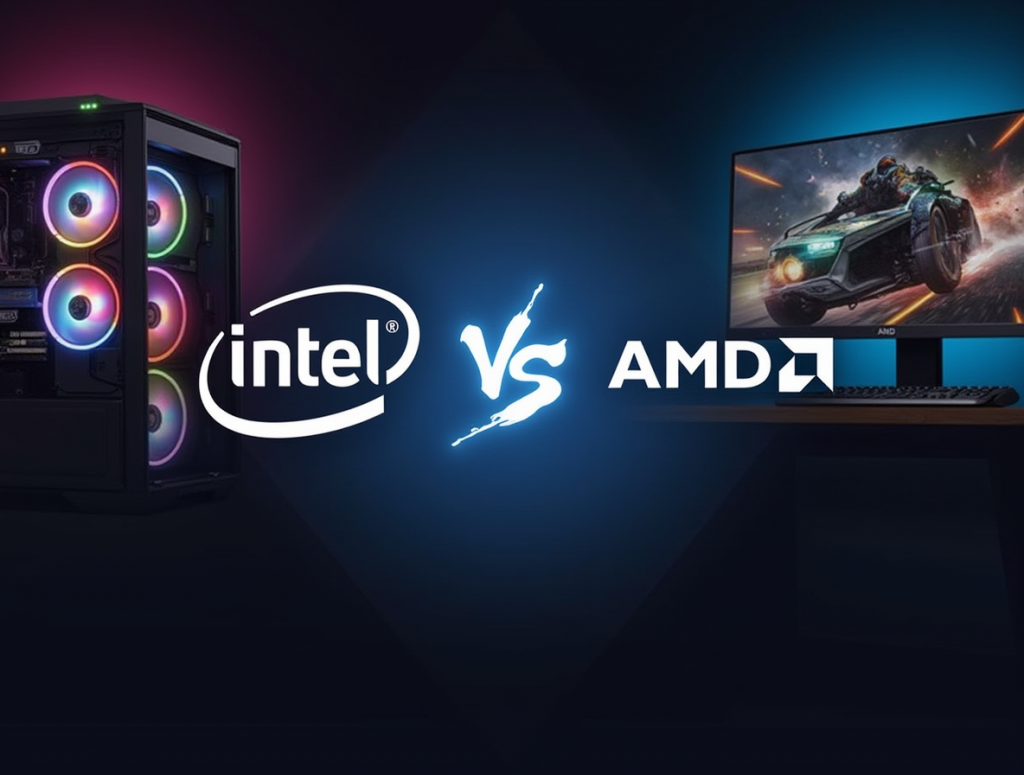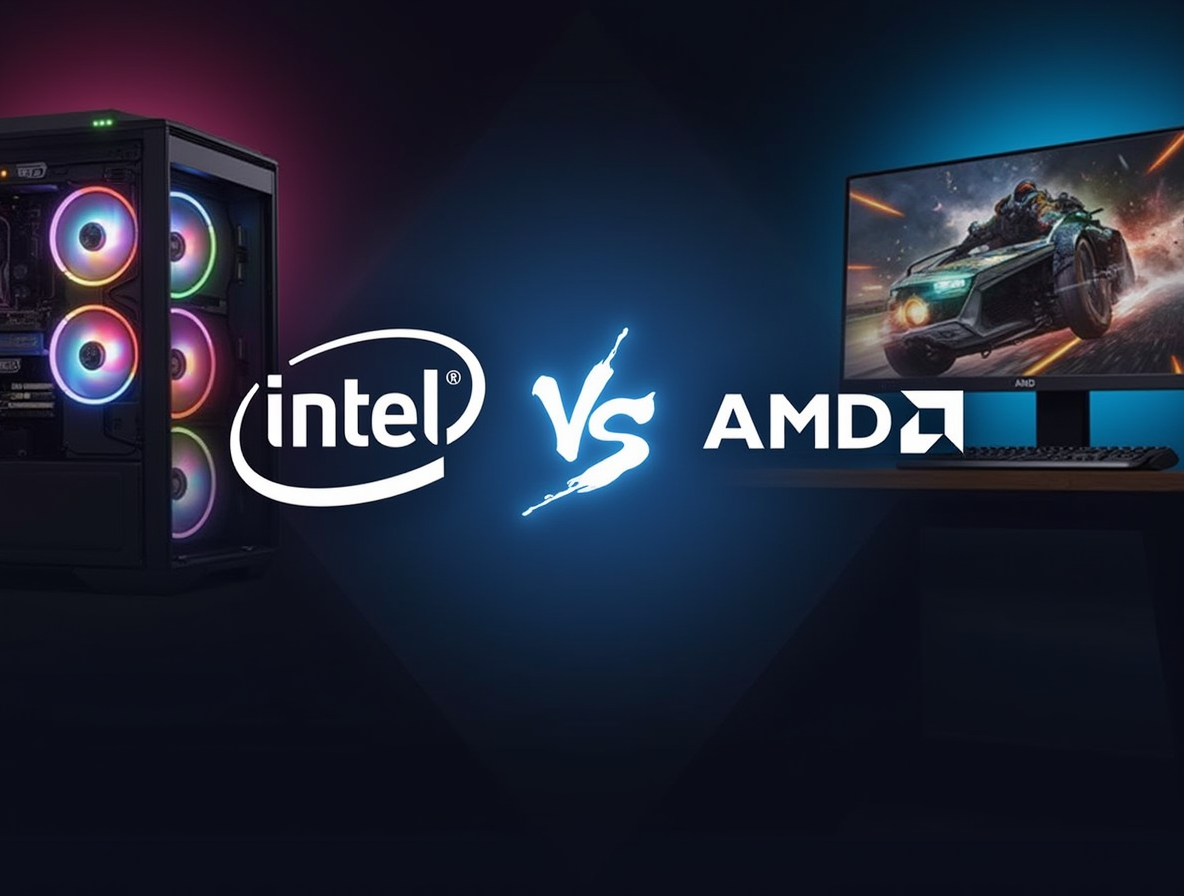
The heart of any gaming PC is undoubtedly its processor. According to recent industry data, gamers spend an average of 25% of their total PC budget on the CPU alone, highlighting just how crucial this component is to the overall gaming experience. Yet, the eternal debate between Intel and AMD continues to divide the gaming community, with each camp fiercely defending their preferred manufacturer.
With both companies consistently releasing new generations of processors with impressive specifications and performance claims, making an informed choice has never been more challenging. Many gamers find themselves caught in analysis paralysis, unsure whether to invest in Intel’s raw gaming performance or AMD’s multi-threaded value proposition. This comprehensive comparison will cut through the marketing hype and provide you with concrete, data-driven insights to help you select the processor that best matches your gaming needs, budget constraints, and future performance expectations.
Understanding CPU Architecture and Gaming Performance
How Processors Impact Gaming
Before diving into the Intel vs. AMD comparison, it’s important to understand how processors affect gaming performance:
- Single-Core Performance: Many games rely heavily on single-threaded performance, which determines how quickly a processor can execute individual instructions
- Multi-Core Performance: Modern games are increasingly optimized to utilize multiple cores, distributing workloads across several processing units
- Cache Size and Speed: Larger, faster cache memory improves instruction and data access times
- Instruction Sets: Specialized instruction sets can accelerate certain types of calculations common in gaming
Key Architecture Differences
Intel Architecture
Intel’s current gaming processors primarily use their hybrid architecture combining:
- Performance cores (P-cores) for demanding gaming and primary tasks
- Efficient cores (E-cores) for background processes and multitasking
- Intel Thread Director technology to optimize workload distribution
This approach allows Intel to deliver strong single-threaded performance while still providing multi-threaded capabilities.
AMD Architecture
AMD utilizes their chiplet-based Zen architecture featuring:
- Unified core design across all processors
- Higher core and thread counts at comparable price points
- Extensive L3 cache (“AMD 3D V-Cache” in premium models)
- Advanced memory controller integration
AMD’s design philosophy focuses on core density and efficient multitasking while continuously improving single-thread performance.
Gaming Performance Comparison
Raw Frame Rate Benchmarks
Recent benchmarks across popular gaming titles show interesting patterns:
Intel Strengths:
- Consistently higher frame rates in competitive esports titles (CS2, Valorant, Fortnite)
- Superior performance in older games that rely heavily on single-thread performance
- Better performance in games using certain graphics APIs
AMD Strengths:
- Competitive frame rates in modern AAA titles
- Better performance scaling when games utilize more cores
- Stronger performance in games that benefit from larger cache sizes
According to Digital Foundry’s comprehensive 2025 testing, Intel’s top-tier processors maintain a 5-12% frame rate advantage in most gaming scenarios, though this gap narrows significantly at higher resolutions where GPU limitations become more prominent.
Value Performance Assessment
When considering performance-per-dollar metrics:
- AMD typically offers more cores and threads at equivalent price points
- Intel commands a premium but delivers marginally better gaming performance
- Mid-range AMD processors often outperform similarly-priced Intel alternatives in mixed workloads
For pure gaming value, the mid-range processors from both manufacturers (Intel Core i5 and AMD Ryzen 5 series) typically represent the sweet spot of performance versus cost.
Platform Ecosystem and Features
Motherboard Compatibility and Longevity
Intel Socket and Chipset Strategy:
- More frequent socket changes historically
- Limited backward/forward compatibility between generations
- Feature-rich motherboard options with varying price points
AMD Socket and Chipset Approach:
- Longer socket retention periods
- Better cross-generational CPU compatibility
- More consistent feature sets across price tiers
AMD’s AM5 platform promises support through at least 2025/2026, while Intel’s latest LGA 1700 socket is expected to be replaced sooner based on historical patterns.
Memory and PCIe Support
Both manufacturers support cutting-edge connectivity:
- PCIe 5.0 support for graphics and storage
- DDR5 memory compatibility
- Multiple M.2 slots for high-speed storage
AMD has traditionally offered more PCIe lanes at comparable price points, benefiting users with extensive peripheral requirements.
Power Efficiency and Thermal Performance
Power Consumption
Gaming power efficiency shows notable differences:
- Intel processors typically draw more power under full gaming loads
- AMD offers better performance-per-watt in most scenarios
- Higher-end Intel processors may require more robust cooling solutions
Tests from Hardware Unboxed demonstrate that under identical gaming workloads, comparable AMD processors consume approximately 15-25% less power than their Intel counterparts.
Thermal Considerations
Thermal characteristics impact both cooling requirements and sustained performance:
- Intel CPUs tend to run hotter at maximum performance
- AMD processors generally maintain lower temperatures under sustained loads
- Both manufacturers implement effective thermal throttling to prevent damage
For users with compact builds or limited cooling capacity, AMD’s thermal efficiency can be a significant advantage.
Beyond Gaming: Streaming and Content Creation
Streaming While Gaming
For the growing number of gamers who also stream their gameplay:
- AMD’s higher core counts benefit CPU-based encoding
- Intel’s QuickSync provides hardware encoding advantages when not using a discrete GPU
- Both platforms handle streaming with minimal gaming performance impact when properly configured
Content Creation Performance
Many gamers also edit videos of their gameplay:
- AMD maintains a clear advantage in heavily multi-threaded content creation tasks
- Intel has narrowed this gap with their hybrid architecture
- Video encoding times favor AMD at similar price points
For pure gaming, Intel’s small performance lead might be persuasive, but for gaming plus content creation, AMD’s multi-threaded advantage often provides better overall value.
Price Analysis and Value Proposition
Current Market Positioning
As of early 2025, the price positioning shows:
- Entry-level gaming: AMD offers stronger options under $150
- Mid-range ($200-350): Fierce competition with trade-offs between gaming and multitasking
- High-end ($400+): Intel maintains a slight gaming edge but at higher power consumption
Total Platform Cost
When considering the complete platform:
- AMD motherboards are typically less expensive for comparable features
- Intel platforms may require more robust cooling solutions
- AMD systems often require less power supply capacity
These factors can offset the processor price differences, making total system cost calculations important.
Future-Proofing Considerations
Upgrade Paths
Long-term value includes potential upgrade options:
- AMD’s longer socket support provides more CPU upgrade options without motherboard replacement
- Intel typically offers more performance improvement with each generation
- Both platforms support the latest standards for peripherals and connectivity
Gaming Trend Alignment
The future of gaming performance appears to be trending toward:
- Increased thread utilization in games
- Higher memory bandwidth requirements
- Better integration with GPU processing pipelines
Both manufacturers are positioning their architectures to align with these trends, though AMD’s higher core counts may provide an advantage as games continue to improve multi-threading.
Making Your Decision
The ideal choice depends on your specific priorities:
- For maximum frame rates in competitive gaming: Intel’s flagship processors maintain an edge
- For streaming while gaming: AMD’s additional cores provide better multitasking
- For balanced gaming and productivity: AMD typically offers better value
- For overclocking enthusiasts: Intel processors generally offer more headroom
Consider also your:
- Budget constraints
- Cooling capabilities
- Future upgrade plans
- Additional workloads beyond gaming
Conclusion
The Intel vs. AMD debate for gaming processors has never been closer, with both companies offering compelling options. Intel maintains a slight edge in pure gaming performance, particularly in scenarios demanding the highest possible frame rates. AMD counters with better multi-threaded performance, power efficiency, and platform longevity.
For most gamers, either platform will provide an excellent experience, with the differences becoming apparent only at the extremes of competitive gaming or when combining gaming with demanding productivity tasks. The decision ultimately comes down to specific use cases, budget considerations, and personal preferences regarding ecosystem and future upgrade paths.
Rather than focusing exclusively on brand loyalty, today’s gamers benefit most from evaluating their specific gaming habits, additional workloads, and budget to determine which processor family best aligns with their individual needs.
FAQ Section
Which CPU is better for esports and competitive gaming?
Intel processors typically deliver higher frame rates in esports titles that benefit from strong single-threaded performance, often providing 5-15% higher FPS in games like CS2 and Valorant, which can be meaningful for competitive players.
Do I need an 8-core processor for gaming in 2025?
While 6 cores remain sufficient for most current games, newer titles are increasingly optimized for 8+ cores. For future-proofing and smooth gameplay with background tasks, an 8-core processor is becoming the recommended standard.
How important is CPU cache size for gaming performance?
Cache size significantly impacts gaming performance, particularly in open-world and simulation games. AMD’s processors with 3D V-Cache technology demonstrate 10-15% better performance in cache-sensitive titles compared to their standard counterparts.
Does choosing AMD or Intel affect which graphics card I should buy?
Both CPU brands work equally well with NVIDIA and AMD graphics cards without any compatibility issues. The choice of processor should be independent of your GPU selection, focusing instead on overall system balance and performance targets.
How often should I upgrade my gaming CPU?
For most gamers, a quality processor should remain viable for 3-5 years. AMD’s longer socket support potentially extends this timeline by allowing CPU upgrades without motherboard replacement, which can be a cost-saving advantage for frequent upgraders.














